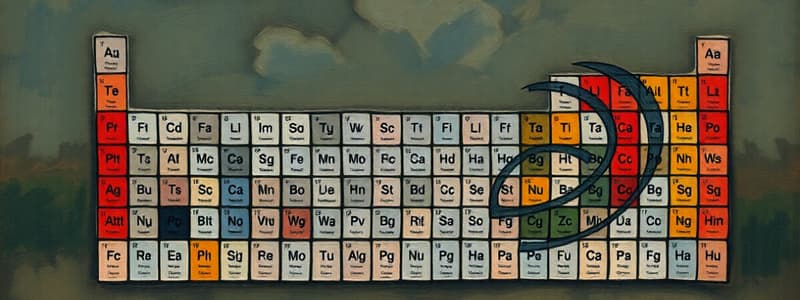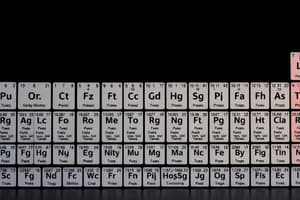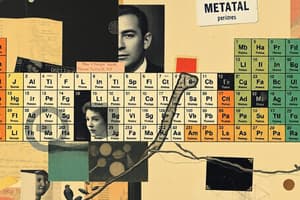Podcast
Questions and Answers
Which element is the only liquid non-metal at room temperature?
Which element is the only liquid non-metal at room temperature?
- Bromine (correct)
- Chlorine
- Oxygen
- Nitrogen
Which of the following properties is characteristic of metals?
Which of the following properties is characteristic of metals?
- Brittle and dull
- Shiny and ductile (correct)
- Poor conductors of heat
- Flammable and gaseous
What is the primary position of non-metals on the periodic table?
What is the primary position of non-metals on the periodic table?
- Upper right portion (correct)
- Upper left portion
- Lower left portion
- Middle section
Which of the following statements about metalloids is true?
Which of the following statements about metalloids is true?
Which statement best describes the physical properties of non-metals?
Which statement best describes the physical properties of non-metals?
What is a defining characteristic of a chemical family in the periodic table?
What is a defining characteristic of a chemical family in the periodic table?
What challenge did Mendeleev face when creating his periodic table?
What challenge did Mendeleev face when creating his periodic table?
Which two families are identified as the first in the periodic table?
Which two families are identified as the first in the periodic table?
What is the significance of the missing elemental information in period 7?
What is the significance of the missing elemental information in period 7?
Which puzzle is described as having more varying properties that make it complex?
Which puzzle is described as having more varying properties that make it complex?
Which property of non-metals is utilized in insulating materials, such as double-glazed windows?
Which property of non-metals is utilized in insulating materials, such as double-glazed windows?
What is the main consequence of tantalum mining in central Africa?
What is the main consequence of tantalum mining in central Africa?
What is the estimated decline in the population of the eastern lowland gorilla since the mining boom began?
What is the estimated decline in the population of the eastern lowland gorilla since the mining boom began?
What happens to hazardous components from discarded cell phones if not properly recycled?
What happens to hazardous components from discarded cell phones if not properly recycled?
Which of the following is a recommended action to promote cellphone recycling?
Which of the following is a recommended action to promote cellphone recycling?
Which characteristic is NOT associated with metals?
Which characteristic is NOT associated with metals?
What type of element is tantalum classified as?
What type of element is tantalum classified as?
Why is recycling cell phones beneficial for wildlife?
Why is recycling cell phones beneficial for wildlife?
Which statement accurately describes non-metals?
Which statement accurately describes non-metals?
What is a compound?
What is a compound?
Which of the following elements is classified as an alkali metal?
Which of the following elements is classified as an alkali metal?
Which group contains elements that are generally unreactive and stable?
Which group contains elements that are generally unreactive and stable?
Which alkaline earth metal is essential for maintaining strong bones and teeth?
Which alkaline earth metal is essential for maintaining strong bones and teeth?
What is a common use of chlorine outside of its reactivity?
What is a common use of chlorine outside of its reactivity?
Which statement about halogens is true?
Which statement about halogens is true?
Which of the following is a property of alkali metals?
Which of the following is a property of alkali metals?
What color is produced by argon when an electrical current passes through it?
What color is produced by argon when an electrical current passes through it?
Why is strontium important for marine life?
Why is strontium important for marine life?
What common characteristic do alkali metals share?
What common characteristic do alkali metals share?
Which of the following is NOT a characteristic of alkaline earth metals?
Which of the following is NOT a characteristic of alkaline earth metals?
Which element is an example of an alkaline earth metal?
Which element is an example of an alkaline earth metal?
How are elements in the same group of the periodic table generally related?
How are elements in the same group of the periodic table generally related?
What is a key difference between alkali metals and alkaline earth metals?
What is a key difference between alkali metals and alkaline earth metals?
Which of the following properties is NOT associated with metals?
Which of the following properties is NOT associated with metals?
Where are non-metals primarily located on the periodic table?
Where are non-metals primarily located on the periodic table?
Why are metals like lithium, sodium, and potassium specifically noted for their surface appearance?
Why are metals like lithium, sodium, and potassium specifically noted for their surface appearance?
Which of the following elements is a liquid non-metal?
Which of the following elements is a liquid non-metal?
What is the general appearance of non-metals?
What is the general appearance of non-metals?
What is an essential skill developed through the Element Scavenger Hunt activity?
What is an essential skill developed through the Element Scavenger Hunt activity?
What materials are suggested for the Element Scavenger Hunt?
What materials are suggested for the Element Scavenger Hunt?
Which statement accurately describes elements in the same family on the periodic table?
Which statement accurately describes elements in the same family on the periodic table?
What distinguishes the Alkali Metals from other groups in the periodic table?
What distinguishes the Alkali Metals from other groups in the periodic table?
What is true about periods on the periodic table?
What is true about periods on the periodic table?
Which of the following elements belongs to the group of Halogens?
Which of the following elements belongs to the group of Halogens?
Why are alkali metals rarely found in their pure form?
Why are alkali metals rarely found in their pure form?
What state of matter is bromine (Br) at room temperature?
What state of matter is bromine (Br) at room temperature?
Which characteristic is NOT associated with Noble Gases?
Which characteristic is NOT associated with Noble Gases?
Which halogen is known to be used in disinfectants for scrapes and cuts?
Which halogen is known to be used in disinfectants for scrapes and cuts?
How did Mendeleev originally organize the periodic table?
How did Mendeleev originally organize the periodic table?
In the periodic table, how do elements in the same column compare in terms of properties?
In the periodic table, how do elements in the same column compare in terms of properties?
What defines a chemical family in the periodic table?
What defines a chemical family in the periodic table?
What was a significant achievement of Dmitri Mendeleev regarding the periodic table?
What was a significant achievement of Dmitri Mendeleev regarding the periodic table?
Which halogen is considered especially toxic even in small amounts?
Which halogen is considered especially toxic even in small amounts?
What physical state do chlorine (Cl) and fluorine (F) share at room temperature?
What physical state do chlorine (Cl) and fluorine (F) share at room temperature?
What role does bromine play in light bulbs?
What role does bromine play in light bulbs?
What trend is observed in the reactivity of elements across a horizontal row in the periodic table?
What trend is observed in the reactivity of elements across a horizontal row in the periodic table?
Which statement accurately distinguishes between an element and a compound?
Which statement accurately distinguishes between an element and a compound?
Which of the following is NOT a property of metals?
Which of the following is NOT a property of metals?
Which comparison correctly identifies the relationship between elements and the periodic table?
Which comparison correctly identifies the relationship between elements and the periodic table?
Which of the following could be identified as a metalloid?
Which of the following could be identified as a metalloid?
What characteristic makes copper and aluminum well-suited for cookware?
What characteristic makes copper and aluminum well-suited for cookware?
Which property typically characterizes non-metals?
Which property typically characterizes non-metals?
Why is bronze classified as a mixture rather than an element?
Why is bronze classified as a mixture rather than an element?
What unique property distinguishes carbon from other non-metals?
What unique property distinguishes carbon from other non-metals?
What was the primary reason Mendeleev left empty spaces in the periodic table?
What was the primary reason Mendeleev left empty spaces in the periodic table?
How did Mendeleev organize the elements in his periodic table?
How did Mendeleev organize the elements in his periodic table?
Which of the following properties of germanium matched Mendeleev's predictions?
Which of the following properties of germanium matched Mendeleev's predictions?
Which statement accurately reflects the current understanding of period 7 in the periodic table?
Which statement accurately reflects the current understanding of period 7 in the periodic table?
What is the significance of Mendeleev's predictions regarding gallium and germanium?
What is the significance of Mendeleev's predictions regarding gallium and germanium?
Which property did Mendeleev predict for germanium in relation to its bonding with oxygen?
Which property did Mendeleev predict for germanium in relation to its bonding with oxygen?
Who has authority over the addition of new elements in the periodic table?
Who has authority over the addition of new elements in the periodic table?
What impact did Mendeleev's work have on the understanding of chemical properties of elements?
What impact did Mendeleev's work have on the understanding of chemical properties of elements?
Why might the process of adding new elements to the periodic table be considered effective?
Why might the process of adding new elements to the periodic table be considered effective?
What arrangement choice did Mendeleev make that contributed to the irregular shape of the periodic table?
What arrangement choice did Mendeleev make that contributed to the irregular shape of the periodic table?
Flashcards
Element
Element
A pure substance that cannot be broken down into simpler substances by any physical or chemical means.
Compound
Compound
A pure substance composed of two or more different elements chemically combined in a fixed ratio.
Metal
Metal
An element that is generally shiny, conducts heat and electricity well, and can be hammered into thin sheets and drawn into wires.
Nonmetal
Nonmetal
Signup and view all the flashcards
Metalloid
Metalloid
Signup and view all the flashcards
Thermal Insulation
Thermal Insulation
Signup and view all the flashcards
Tantalum
Tantalum
Signup and view all the flashcards
Recycling
Recycling
Signup and view all the flashcards
E-Waste Recycling
E-Waste Recycling
Signup and view all the flashcards
Habitat Destruction
Habitat Destruction
Signup and view all the flashcards
Ductility
Ductility
Signup and view all the flashcards
Malleability
Malleability
Signup and view all the flashcards
Chemical Family
Chemical Family
Signup and view all the flashcards
Alkali and Alkaline Earth Metals
Alkali and Alkaline Earth Metals
Signup and view all the flashcards
Period
Period
Signup and view all the flashcards
Mendeleev's Contributions
Mendeleev's Contributions
Signup and view all the flashcards
Last Two Families
Last Two Families
Signup and view all the flashcards
Alkali Metals and Alkaline Earth Metals
Alkali Metals and Alkaline Earth Metals
Signup and view all the flashcards
Halogens and Noble Gases
Halogens and Noble Gases
Signup and view all the flashcards
Mendeleev's Periodic Table
Mendeleev's Periodic Table
Signup and view all the flashcards
Why are alkali metals rarely found pure?
Why are alkali metals rarely found pure?
Signup and view all the flashcards
Periodic Table
Periodic Table
Signup and view all the flashcards
Conductivity
Conductivity
Signup and view all the flashcards
Alkali Metals
Alkali Metals
Signup and view all the flashcards
Alkaline Earth Metals
Alkaline Earth Metals
Signup and view all the flashcards
What is the significance of elements being in the same group on the periodic table?
What is the significance of elements being in the same group on the periodic table?
Signup and view all the flashcards
Describe the properties of alkali metals.
Describe the properties of alkali metals.
Signup and view all the flashcards
Noble Gases
Noble Gases
Signup and view all the flashcards
Halogens
Halogens
Signup and view all the flashcards
What are the main characteristics of alkaline earth metals?
What are the main characteristics of alkaline earth metals?
Signup and view all the flashcards
Lithium
Lithium
Signup and view all the flashcards
What is a chemical family?
What is a chemical family?
Signup and view all the flashcards
What determines the number of electron shells an element has?
What determines the number of electron shells an element has?
Signup and view all the flashcards
Sodium
Sodium
Signup and view all the flashcards
Potassium
Potassium
Signup and view all the flashcards
Calcium
Calcium
Signup and view all the flashcards
Group (Periodic Table)
Group (Periodic Table)
Signup and view all the flashcards
Period (Periodic Table)
Period (Periodic Table)
Signup and view all the flashcards
Reactivity Trend (Group)
Reactivity Trend (Group)
Signup and view all the flashcards
Reactivity Trend (Period)
Reactivity Trend (Period)
Signup and view all the flashcards
Who invented the periodic table?
Who invented the periodic table?
Signup and view all the flashcards
How was the periodic table organized?
How was the periodic table organized?
Signup and view all the flashcards
What is an element?
What is an element?
Signup and view all the flashcards
What is a compound?
What is a compound?
Signup and view all the flashcards
What is a metal?
What is a metal?
Signup and view all the flashcards
What is a nonmetal?
What is a nonmetal?
Signup and view all the flashcards
What is a metalloid?
What is a metalloid?
Signup and view all the flashcards
What is the significance of the bold staircase line on the periodic table?
What is the significance of the bold staircase line on the periodic table?
Signup and view all the flashcards
Are there more metallic or nonmetallic elements on the periodic table?
Are there more metallic or nonmetallic elements on the periodic table?
Signup and view all the flashcards
What makes copper and aluminum ideal for pots and pans, and silver and gold ideal for jewelry?
What makes copper and aluminum ideal for pots and pans, and silver and gold ideal for jewelry?
Signup and view all the flashcards
Mendeleev's Predictions
Mendeleev's Predictions
Signup and view all the flashcards
Periods on the Periodic Table
Periods on the Periodic Table
Signup and view all the flashcards
Groups on the Periodic Table
Groups on the Periodic Table
Signup and view all the flashcards
Periodic Trends
Periodic Trends
Signup and view all the flashcards
Period 7 of the Periodic Table (Incomplete)
Period 7 of the Periodic Table (Incomplete)
Signup and view all the flashcards
Adding Elements to the Periodic Table
Adding Elements to the Periodic Table
Signup and view all the flashcards
Validation Process for New Elements
Validation Process for New Elements
Signup and view all the flashcards
Constantly Evolving Periodic Table
Constantly Evolving Periodic Table
Signup and view all the flashcards
Effectiveness of Adding Elements
Effectiveness of Adding Elements
Signup and view all the flashcards
Study Notes
Periodic Table
- Elements are the building blocks of all substances
- Elements are arranged in a particular way in the periodic table
- Elements in the same column have similar physical and chemical properties.
- Elements in the same row show trends in increasing or decreasing reactivity, depending on the group.
- The first two families on the periodic table are the alkali metals and the alkaline earth metals.
- The last two families are the halogens and the noble gases.
- A chemical family is a column of elements on the periodic table
- Elements in the same chemical family have similar properties.
Studying That Suits You
Use AI to generate personalized quizzes and flashcards to suit your learning preferences.




